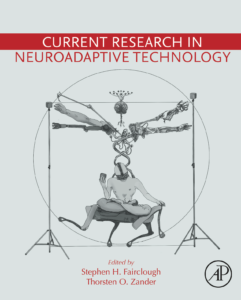A collection of chapters and abstracts from both 2017 and 2019 Neuroadaptive Technology conferences were published last week by Elsevier, edited by myself and Thorsten Zander. You can find full details about the content of the book directly from the Elsevier website here.
I’ve reproduced the preface from the collection below to give a sense of what the collection is about and how the book and the conferences came to be.
“Back in the late noughties, there was a period of intensified interest in the concept of a brain-computer interfaces (BCI). The idea of using real-time measures of brain activity to communicate directly with a computer was nothing new, but BCI research (at the time) was generally constrained to medical applications and clinical groups. The primary impetus for increased interest in the topic was the idea that people without clinical conditions could utilise BCIs, which stimulated enormous discussion about what kinds of applications were possible. There was a feeling back then that BCI research, which had been highly niche and specialised, was spilling over into the relative mainstream of human-computer interaction.
Those early conference sessions and workshops were dominated by research on active BCI, where neurophysiological signals represent active intentions and serve as a proxy for an input control device like a mouse or a joystick. We were in a minority during those early sessions because we were both working on system concepts where physiology was monitored implicitly, and the interface adapted with no requirement for active cognition on behalf of the user. One of us had developed the existing concept of physiological computing into a broad category of technology where systems adapted to implicit changes in neurophysiology and psychophysiology, united by the cybernetic concept of closed-loop control. The other had extended the concept of a BCI to include an approach called passive BCI, which implicitly monitored the user and allowed the system to develop context awareness.
When we talked, we discovered that we had at least two things in common, we were both interested in closed-loop control using signals from the brain and the body and we experienced a shared frustration that our work didn’t fit comfortably into existing conference forums. As we both regularly attended a range of meetings, we could see work on this topic of implicit monitoring being submitted and presented, but presentations often emphasised one specific aspect, such as sensors or signal processing aspects or machine learning, which depended on the specific focus of the conference. We both felt that the ‘passive’ approach was important enough to warrant its own scientific meeting where all aspects of the closed loop design were equally represented, from sensors to signal treatment through to interface design and evaluation of the user experience.
The first step was a meeting devoted to passive BCI held in Demelhorst just outside Bremen over two (very hot) days in August 2014. On the final morning of that meeting, along with the other attendees, we batted around various names with which to label this emerging category of research. We wanted a name that was inclusive and could cover all aspects of these closed-loop systems. We had a wide range of attendees in the room, so finding a name that everyone could completely endorsed proved to be quite a challenge. The term ‘neuroadaptive technology’ (appropriated from a 2003 paper from Lawrence Hettinger and colleagues) was the label that people were least unhappy about – and so, when we organised our first international conference in Berlin in the summer of 2017, that was the name we ran with.
Our fundamental thinking behind the neuroadaptive technology conference is that despite an enormous range of applications, from autonomous driving to marketing, research on this technology rests on number of core topics, such as: measurement, signal processing methods, machine learning, and the design of implicit human-computer interaction. The idea of the conference was to invite submissions on those topics that converge on the concept of closed-loop monitoring of implicit physiology to enhance human-computer interaction.
In 2019, we held the second international conference on neuroadaptive technology in Liverpool and this edited collection is based on the work presented at that particular event. Aside from the two introductory chapters from ourselves, the other work in this volume represents selected contributions to the 2019 conference. We’ve been lucky enough to have a variety of excellent keynote speakers included in the programme at both conferences, in addition to general submissions. The contributions from our keynote speakers, Robert Jacob, Makoto Miyakoshi, Surjo Soekadar, Tim Mullen and Pim Haselager in 2017, and Frederic Dehais, Romy Lorenz, Graeme Moffat, Erin Solovey and Fabien Lotte in 2019, were greatly appreciated. The meetings were also endorsed by the presence of industry, such as Brain Products, mBrain Train, and Zander Laboratories – and we are grateful for their support.
In planning this selected collection of chapters, we asked our keynote speakers to score the work that was presented over the three days of the 2019 meeting and the highest scoring contributions are included in this published volume. Also, for the sake of completion, a full list of presentations and abstracts for both the 2017 and 2019 meetings have been added at the end of this book.
We’d like to thank everyone who attended the meetings and made them such enjoyable events. We’d also like to acknowledge support and assistance from our postgraduate research students (Laurens Krol, Lena Andreessen, Kellyann Stamp, Christopher Baker) during the planning and organisation of both events; a special additional thanks to Christopher Baker who provided the cover illustration.
Stephen Fairclough
Thorsten Zander
October 2021″
